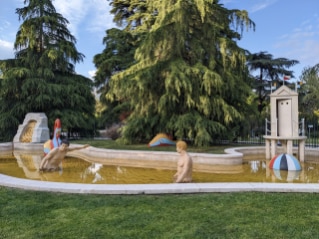Heptacaidecaphobia, the fear of the number 17, is an all-Italian belief that has several preconceptions attached to it, mainly linked to popular culture and superstition, especially when this number is coincidental with Friday. A sign of bad luck.
Paul Valery claimed that intelligence can coexist with the grossest superstitions. This is absolutely true.
Images and simulacra had a primary function in every culture, their function being to protect people from demons and the inauspicious fortunes of chance, and throughout the history of art they have been represented countless times. Images, gestures, shapes and figures were used to invoke good luck, to act on memory, and to ward off misfortune.

The Virgin Mary is presented as a religious emblem, a point of reference against the devil, against evil. She intercedes for humanity and it is her task to crush the head of the devil, of evil.
Giambattista Tiepolo created an extraordinarily beautiful artwork between 1767 and 1768 - The Immaculate Conception. Here, the Madonna is depicted according to the most traditional iconography. Wrapped in white robes and wearing a big blue cloak, the Virgin is painted by the artist according to the biblical description in the book of Revelation (12:1-3): “A great sign appeared in heaven: a woman clothed with the sun, with the moon under her feet and a crown of twelve stars on her head. She was pregnant and cried out in pain as she was about to give birth. Then another sign appeared in heaven: an enormous red dragon with seven heads and ten horns and seven crowns on its heads”.

Tiepolo portrays her as proud, confident, looking at the viewer, towards humanity, between lively angels accompanying and supporting her. In a beautiful pictorial exercise, Tiepolo draws on the style of Giovanni Battista Piazzetta and Sebastiano Ricci, achieving a surprising plasticity of drapery. The most fascinating detail, however, is at her feet. Mary steps on a snake, a dragon, a monster. This hideous creature holds an apple in its mouth, a clear reference to the Garden of Eden and the original sin. A palm branch, a mirror, is hidden on the lower left side of the painting. The palm is used to represent the Virgin’s victory over evil, while the mirror, a symbol of truth, refers to her purity.
The popular superstition associated with Friday the 17th goes back to biblical events, not by chance it is on a Friday that Christ died. But it is not only religion that addressed this theme, which is also dealt with by ancient philosophers and mathematicians. For the Pythagoreans, in fact, 17 was an adverse number because it was located between 16 and 18, numbers that for them reflected the representation of quadrilaterals 4×4 and 3×6, hence perfection.

In a bas-relief dating back to the 15th century, probably made by an unknown artist from northern Italy, we find a satyr with a cup and a thyrsus, making a typical superstitious sign - the horns. A symbol of strength and virility, horns also take on superstitious symbolism dedicated precisely to warding off evil, bad luck. It is no coincidence that tourists of various nationalities still buy and seek out the typical red horn in the city of Naples.
Evil, misfortune, bad luck. A Friday the 17th that follows pandemics and wars. A Friday the 17th that, contrary to popular tradition, could, perhaps, bring about peace and good luck.










